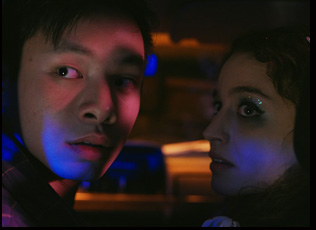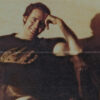For the first little bit of “The Three Men You Meet at Night,” all you hear is the footsteps of a young woman named Jess (Stella Baker), gingerly walking home from a party well past midnight on a deserted street where each time her heels hit the granite, there’s suspense quite literally in when — or whether — the other shoe will drop. Surely, the 16-year-old has strolled down this road before, but things start to appear different to her when she’s looked at differently, approached by a boy she’s long considered a friend (Barron Leung), whose invitation to give her a ride home seems more by hormones than a desire to help, and she can’t be sure the arrival of a cop (Walker Hare) is going to offer her any protection. It’s a situation that was loosely inspired by real life for writer/director Beck Kitsis when she was coming of age, slightly intrigued and more than a little frightened by this newfound power that she had over the opposite sex and in recasting her experience as a proper horror film, she exudes total confidence in her directorial debut, which has stood out at recent shorts programs at Fantastic Fest and Nightstream.
With the film’s recent debut through Alter making it available to watch right this minute, Kitsis spoke about making the transition from being a producer to the director’s chair, injecting a sense of realism into a stylized thriller and turning tropes of the genre and societal presumptions on their ear.

It was a bit tricky to set the short up. Usually, I’ll have an idea for a film gestating for a long time, and then suddenly feel this urgent need to make it right then and there. And that’s exactly what happened with “The Three Men You Meet at Night.” So our preproduction schedule was kind of crazy! Between the time I called one of the producers Kay Sorin and asked, “Can you help me make this movie?” to when we shot it, it was probably only a month-and-a-half. And that included fundraising too. It was a quick process, but it was really fun.
In addition to the short prep time, our production was also tricky because so much of the movie takes place at night on a residential street. So with such a quick pre-production schedule, [it was difficult] finding the right locations and then figuring out how to permit properly to keep everybody safe. We also shot the film over a course of about two nights and then we had an afternoon shoot [for the film’s last scene], so we were mostly doing night shoots from 7 pm until the sun rose around 4:30 [in the morning]. [laughs] Yeah, it was brutal, but also very, very fun.
The time you took for lighting pays obvious dividends, really creating a cool world to walk into. What was it like figuring out the color palette for this?
The cinematographer Adam Kolodny is extremely talented and kind. I don’t know if it’s a typical experience to have a cinematographer as committed and dedicated as Adam was not only in production, but also early on in development and late in post, but I was so grateful for that because, as a first-time director, I had a lot of nerves. To further complicate things, I also had pretty lofty ambitions for the film’s lighting and cinematography, considering we were such a small-scale short. Nevertheless, Adam miraculously managed to pull everything off, despite our limited resources.
My whole vision for lighting the film hinged on creating a sort of dreamlike mood — a bit surreal, a bit artificial. And I wanted to do that by using color in unexpected ways — letting the moonlight be purple for example! Adam and I spent most of development figuring out this cinematographic language together. Thankfully, when it came time to execute the lighting, Adam had a small but mighty G&E team to help him. Our gaffer Kieran McShane, Key Grip Dave Williamson, and swing Mason Rice were incredible.
Cars are always tricky to shoot in and around too – was it a challenge?
Yeah, I feel like every film I’ve made, we always have all these ambitions with cars and hostess trays and hood mounts. In prep it’s [always] like, “No, this shoot it’s going to be different! These care setups are going to be really quick this time, definitely!” and then we get to the shoot and it’s of course more complicated than we thought. So that was a challenge for us on this short, too. We were working with this old Volkswagen that someone in the town lent to us, which was really kind, but it also was a bit tricky to rig it up. We had to kill a lot of shots that we had planned to do in that car.
However, limitations also bred creativity. For example, we were devastated when we lost our cop picture car earlier than we had scheduled. That meant that we never got the very important close-ups of Stella reacting to the cop in the backseat. But our brilliant camera, G&E, and production design teams came to the rescue! They worked together to dress and light another car we had access to, to make it look like the interior of the cop car. For legal reasons, we also couldn’t drive the car we shot these pickups in, so we just had people rocking the car back and forth, and shining blue lights on Stella’s face to make it seem like she was in the back of a cop car because the cop car.
You fooled me.
Yeah, they are magical. These people are incredible.

I’m working on a feature film called “Strawberry Summer” and Carlen May-Mann, a producer on this short, was talking to one of our producers on that film, Michael Gottwald, who introduced Carlen to Stella’s agent. We cast all of our other actors through open auditions, but we hadn’t quite found the right fit for Jess. However, when I had a phone call with Stella, it immediately became clear that she just really understood this story. She was absolutely the right person to play the role, and I couldn’t see it any other way. And of course now, I think it’s one of the best choices that we made because her performance is the centerpiece of this film.
This ties in with what you were describing in terms of the lighting, bringing people into a certain world that exists in horror films and she seems instantly iconic in heels and dripping mascara. What went into the look of the character?
I was really interested in drawing on horror iconography. In horror films, women are often ill-equipped to escape whatever monsters they’re facing. They’re always in heels, right? And often crying or having sex. One of my favorite homages to the heels iconography is in the opening scene of “It Follows” when that young woman is running out of her house in stilettos. I was so nervous she was going to trip the whole time! So anyway, yes, I was definitely thinking about things like that — what does a horror protagonist or a “final girl” look like?
Also, in terms of backstory, Jess is coming from a party, so she’s probably dressed not like she thought she’d be walking home alone. I wanted her to feel suddenly uncomfortable in her clothes — she pulls down her shirt to cover her midriff and then more of her chest than maybe she feels comfortable with at that moment is exposed. That sort of thing. So it’s like she’s very much on display [because] the first thing people will say when someone is a victim of sexual harassment or violence is, “Well, she was asking for it. Why was she wearing those clothes?” So I really wanted to make a point by putting her in whatever those clothes might be and still showing that I don’t think she was asking for [such an assault].
This was always called “The Three Men You Meet at Night,” so obviously the structure must’ve been there of meeting these men, but did you always have these specific types of guys she’d meet in mind?
I did, but the one thing that I changed as I was writing the script was “The Guardian” (aka the cop). Originally, I was envisioning him more as a friend’s father…somebody who’s a wolf in sheep’s clothing, somebody who Jess really did trust. However, in terms of plot, I couldn’t figure out a reason for some friend’s dad to be driving around in the middle of the night by an abandoned camp, so ultimately, it had to be somebody who could realistically be in this space and “catch” Richie and Jess.
I always knew I wanted him to be somebody who had more control and power than the previous men. I wanted to create a frightening power imbalance between he and Jess. Making the third man a police officer is really scary because it escalates the amount of authority that he has over her, both socially and physically.

Yes, I’m so excited for people to be seeing the film! In terms of the story living in my head, I have to admit that “Three Men” was really different when I first wrote it two years ago. Originally, I wanted to shoot the whole thing inside a studio with Jess walking a treadmill and cast rear projections behind her to make it feel really artificial and surreal. That would’ve been cool, but extremely different! Perhaps too artificial to pack the punch I wanted for the film. So ultimately I’m really happy with how everything turned out.
Grounding the short in more realism became really important to me because I wanted to drive home how these monsters exist in real life. Interestingly, I’ve been hearing from people who have seen the film at these virtual festivals that, for better or worse, the short makes them feel very uncomfortable. I wasn’t expecting that reception because this experience of being afraid walking home alone at night is so natural for me — I guess discomfort is just a woman’s natural state of being, so I had assumed that a lot of people had this experience. But at the end of the day, I think that the film’s ability to make people feel uncomfortable is its strength. If it’s eliciting that strong of a reaction, then it’s doing something right.
I feel very lucky that we had the chance to make this short.
“The Three Men You Meet at Night” is now streaming here.




